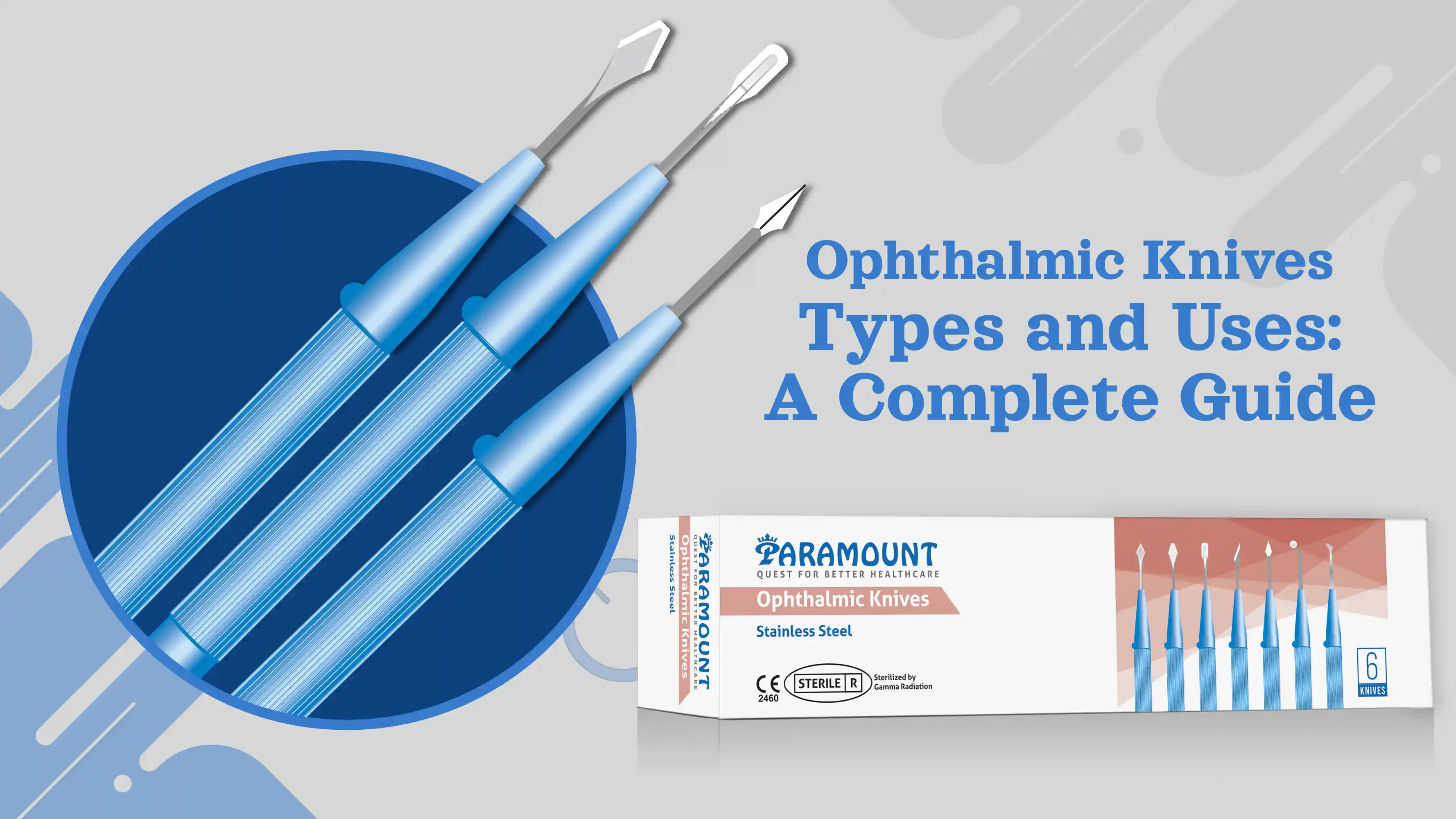Eye surgery is one of the most sensitive areas of healthcare. Every cut, every incision, and every instrument must be designed with the utmost precision to protect the patient’s vision. At the heart of this surgical procedure is the ophthalmic knives, a blade primarily used for corneal, scleral, and retinal procedures.
What are ophthalmic knives? (Simple Definition)
An ophthalmic knife is a small, extremely sharp surgical knife that eye surgeons use to make precise incisions in the cornea, sclera, or retina. Unlike modern surgical knives, these knives are designed for ophthalmic microsurgery, where precision down to the millimeter matters.
Key Features of Ophthalmic Surgical Blades:
- Stainless-metal blades for accuracy and sharpness
- ABS plastic manage for comfort and control
- Sterilized by using gamma radiation to ensure sterility upto 5 years
- Packed in sterile blister pouches for single use
Ophthalmic Knives Types and Their Uses
There are various styles of ophthalmic surgical knives, each designed for a specific step in eye surgical procedure. Let’s smash them down:
1. Slit / Keratome Knives
Purpose: Creates unique corneal incisions all through cataract surgical procedure. Use in surgery: Makes self-sealing wounds that reduce the need for sutures. Knife size: It is available in various widths to match surgical requirements.
2. Crescent knives
Objective: Manual small-incision cataract surgery is used to create scleral tunnels in cataract surgery (MSICS). Benefits: Surgeons also help to focus smoothly as maintaining the balance of the wound.
3. MVR (Micro Vitreoretinal) Knives
Purpose: Essential for retinal and vitreoretinal surgical procedures. Uses: Microsurgical forms aspect-port fry to keep contraception.
4. Lance Tip Knives Purpose:
Creates aspect-port or stab incisions in cataract approaches. Feature: Provides a clean entry with minimum tissue trauma.
5. Spoon and scleral knives
Objective: Used to dissolution and complete internal layers of the eye. Application: Often applied in glaucoma or complex eye surgery. Q: What are the types of ophthalmic knives? A: The most important ophthalmic knives types are made of keratom/slit knives (for corneal incisions), Crescent knives (for scleral tunnels), MVR knives (for retinal access), lance tip knives (for face-port nation), and scrape/spoon knives (for intensive dissection).
Use of ophthalmic knives in eye surgery
Ophthalmic knivees are important:
- Cataract Surgery
- Retina and Vitaroratinal procedures
- Corneal grafting and keratoplasty
- Creation of side-port fry for equipment
- Dissection and tissue removal
Each incision must be controlled, sterile and sharp, which is why most hospitals prefer disposable eye knives.
Global market for ophthalmic knives
The demand for eye surgical blades is increasing worldwide, which is inspired by the prevalence of cataract and the aging population. Regional trends include: India ophthalmic knives market: Rapid adoption due to excessive cataract surgical operation volume. GCC Countries: Increased demand with government-led imaginative and prescient fitness programs. Europe (Italy, France, Spain, Germany, UK): Strong regulatory compliance drives desire for CE-licensed knives. South America & South Korea: Expanding adoption of microsurgical ophthalmic contraptions. Distributors across these regions look for reliable ophthalmic knives manufacturers who meet ISO 13485, CE, and US FDA standards.
Why Safety and Sterility Matter
Ophthalmic knives are classified as surgically invasive, transient-use devices .This approach: Single use handiest: Reusing blades risks infections like Hepatitis or HIV. Sterility guarantee: Sterilized with gamma radiation (25 kGy) to hold hygiene. Safety for surgeons: Designed with ABS handles for better grip and decreased harm dangers. FAQ: Q: Can ophthalmic knives be reused? A: No. Reuse may additionally transmit infections and decrease sharpness, risking surgical errors.
Paramount Surgimed Limited: Globally Trusted Ophthalmic Knives Manufacturer
At Paramount Surgimed Limited, we design and supply a complete range of ophthalmic knives and blades depended on through using surgeons in over a hundred countries.
Product Line Highlights
Models: Keratome, Crescent, Lance Tip, MVR, Spoon, Scleral Stainless-steel blades with ABS handles Sterilized by way of gamma radiation for 5 years shelf life Available in more than one blade sizes for distinctive eye strategies Individually packed in peel-aside blister pouches Certifications ISO 13485 US FDA registered CE certified
Eye surgical knives future
As cataract and retinal surgery continues to expand worldwide, the role of high-end ophthalmic knives will become even more important. Disposable, sterile, and ergonomically designed knives are shaping the future of eye care. Paramount Surgimed continues to innovate with surgeon-friendly designs, ensuring every incision is safe, controlled, and reliable.
Conclusion: Accuracy in every reduction
By understanding the types of ophthalmic knives used for eye treatments, fitness professionals and distributors can understand the importance of specialized surgical blades in eye care. From cataract surgical knives to microsurgical retinal blades, each instrument plays a unique role in restoring vision and improving patient outcomes. For distributors, hospitals and eye surgeons worldwide, our partnerships with leading global brands, including Paramount Surgimed Limited, ensure the satisfaction, safety and compliance of every product.

